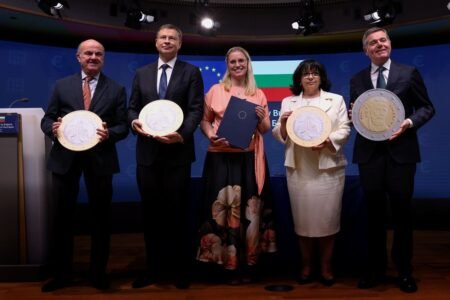(LUXEMBOURG) – An agreement between pharma giants Roche and Novartis to reduce use of Avastin in ophthalmology and increase use of Lucentis could constitute restriction of competition, the EU Court ruled Tuesday.
Both medicinal products Avastin and Lucentis are developed by Roche group company Genentech. Genentech entrusted the commercial exploitation of Lucentis to the Novartis group by way of a licensing agreement. Roche markets Avastin.
Those biotechnological medicinal products were authorised by the European Commission and the European Medicines Agency (EMA). Lucentis is authorised for the treatment of eye diseases. Avastin, while authorised only for the treatment of tumorous diseases, is also frequently used to treat eye diseases because its price is lower than Lucentis.
In 2014, Italy’s competition authority (AGCM) imposed two fines, each of over EUR 90 million, on both Roche and Novartis, on the grounds that they had put in place an arrangement designed to achieve an artificial differentiation between Avastin and Lucentis. According to the AGCM, Avastin and Lucentis are equivalent in all respects for the treatment of eye diseases. Furthermore, the arrangement was intended to disseminate information giving rise to concerns regarding the safety of Avastin used in ophthalmology with a view to causing a shift in demand toward Lucentis. The AGCM claimed that this shift resulted in a cost increase for the Italian health service assessed at approximately 45 million in 2012 alone.
When the actions they had brought against those fines were dismissed, Roche and Novartis lodged an appeal before Italy’s State Council, which referred the matter to the Court of Justice for a preliminary ruling on the interpretation of EU competition law.
In today’s judgment, the European Court of Justice examined first of all whether a national competition authority such as the AGCM may consider that Avastin, although not authorised for the treatment of eye diseases, forms part of the same market as Lucentis, which is specifically authorised for those diseases and, if so, whether the competition authority must take account of the possible unlawfulness of that use of Avastin under the EU rules governing pharmaceutical matters.
The Court recalled that, in principle, medicinal products that may be used for the same therapeutic indications belong to the same market. However, the fact that pharmaceutical products are manufactured or sold unlawfully prevents them from being regarded as substitutable with products manufactured and sold lawfully. Nevertheless, EU rules governing pharmaceutical matters prohibit neither the prescription of a medicinal product outside the conditions laid down in its marketing authorisation (MA) nor its repackaging for such off-label use, provided that they comply with certain conditions. It is not for the AGCM but for the national courts or the competent authorities to verify that those conditions are satisfied. The Court then noted that, for the treatment of eye diseases, there is a specific relationship of substitutability between Lucentis and Avastin when used off label.
The Court concluded that, if the competent authorities and courts have not examined whether the conditions for the repackaging and the off-label prescription of Avastin are unlawful, the AGCM may consider that the two products are in the same market and can therefore be regarded as competing medicinal products. In so far as the competent authorities and courts have examined whether those conditions are unlawful, the AGCM must take account of the outcome of that examination.
The Court precluded that the arrangement between the Roche group and the Novartis group referred to by the AGCM may be justified as ancillary to their licensing agreement. In that regard, the Court observed that the arrangement was not designed to restrict the commercial autonomy of the parties to the licensing agreement regarding Lucentis but rather the conduct of third parties in particular healthcare professionals with a view to reducing the prescription of Avastin in ophthalmology for the benefit of Lucentis. In those circumstances, the arrangement cannot be considered to be ancillary and objectively necessary for the implementation of the licensing agreement.
The Court noted that an arrangement between two undertakings marketing two competing medicinal products, which consists in the dissemination, in a context of scientific uncertainty, to the EMA, healthcare professionals and the general public of misleading information relating to adverse reactions resulting from the off-label use of one of those products with a view to reducing the competitive pressure it exerts on the other product, constitutes a restriction of competition ‘by object’. The Court explains that the information must be considered to be misleading (which is a matter for the national courts to determine) if its purpose is, first, to confuse the EMA and the Commission and, secondly, to emphasise, in a context of scientific uncertainty, the public perception of the risks associated with the off-label use of Avastin.
Lastly, the Court recalled that an arrangement cannot be exempt under Article 101(3) TFEU if it includes restrictions that are not indispensable. The dissemination of misleading information in respect of a medicinal product cannot be regarded as ‘indispensable’. An arrangement intended to disseminate such misleading information therefore cannot be exempt.








